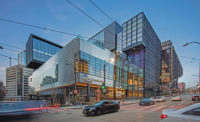Work Begins on Six Flags’ 12.37-MW Solar Project
“The Six Flags Magic Mountain solar project stands as the largest of its kind in the nation, boasting an impressive area exceeding 637,000 sq ft of shade structures.”
—Arno Aghamalian, CEO and Founder, Solar Optimum
An official groundbreaking held Nov. 1 kicked off a 12.37-megawatt solar carport and energy storage system project at Six Flags Magic Mountain, representing the largest single-site commercial renewable energy project in California and the largest U.S. solar project allocated toward a for-profit organization. Solar Optimum and DSD Renewables (DSD) will lead work on the project, which includes a 637,000-sq-ft, 12.37-MW solar carport built over the main guest and team member parking lots.
Upon completion, the park will be able to offset 100% of its total energy usage with solar power, while the additional shade coverage will help keep visitor and staff vehicles cool across the approximately 3,544 guest and 771 team member parking spaces. Scope also includes 30 guest electric vehicle parking spaces.
The onsite battery storage system will produce approximately 2 megawatts of power with up to 8 megawatt hours of capacity that can be deployed daily, while the system will produce 20.8 million kilowatt hours of energy annually.
$38.3M Grant to Improve Safety by Eliminating Doran Street Crossing
The Federal Railroad Administration (FRA) recently awarded a $38.3-million Railroad Crossing Elimination (RCE) Grant to the Doran Street Grade Separation Project. The effort aims to improve safety at the Doran Street crossing, which has one of the highest numbers of safety-related incidents involving vehicles, bicycles or pedestrians in Los Angeles County.
With the RCE grant in hand, the project is now fully funded, and the Los Angeles County Metropolitan Transportation Authority (Metro) plans to start construction in 2025. Metro is providing a 28% local funding match for the FRA grant award to help pay for the $61.8-million project, which is moving into scheduling.
According to Metro, up to 90 trains per day use the tracks in this area, with that volume expected to grow to 116 by project completion in 2027. The project’s second phase is a $220.7-million effort to construct an overpass at Salem and Sperry streets in Glendale.
Upgrades Ahead for Space Needle’s Golden Elevators
Turner Construction Co. is leading an $18-million multiyear effort to replace three iconic golden elevators at Seattle’s Space Needle.
Work will begin with building modifications, while construction will occur at night to allow the facility to remain open to the public during the day. The elevators, which travel on the outside of the building, will be replaced one at a time so the other two can remain open throughout the replacement effort. These elevators are the only way to reach the top of the Space Needle.
“Working on such a notable piece of the Seattle skyline is an honor,” Bill Ketcham, vice president and general manager at Turner, said in a statement. “The elevators are an integral part of the Space Needle, and we look forward to bringing them into the 21st century.”
The project is expected to take four years, with the first elevator scheduled for completion in May 2025.
Next Phase Set for San Diego LOSSAN Rail Realignment
A single railroad track in the city of Del Mar travels atop coastal bluffs that are rapidly eroding and threatened by sea level rise. The San Diego Association of Governments’ (SANDAG) Los Angeles-San Diego-San Luis Obispo (LOSSAN) Rail Realignment Project will relocate about five miles of this rail line inland.
HDR will lead environmental clearance and advanced conceptual engineering on the project. The design firm has worked with SANDAG since 2020 on the San Diego Regional Rail Alternatives Analysis and Conceptual Engineering Study that set the groundwork for the realignment.
In partnership with Mott MacDonald and several other firms, HDR will collaborate with SANDAG to complete the California Environmental Quality Act and National Environmental Policy Act processes in 2026 to support the goal of opening the relocated rail line by 2035.
While a new double-track alignment will be constructed away from the bluffs, the project team is currently analyzing the best alternate track realignment strategy, including a tunnel portion between Los Penasquitos Lagoon and San Dieguito Lagoon. This project will enhance safety, reliability and increase capacity along the LOSSAN Rail Corridor. The realignment will also be the first on the LOSSAN Corridor designed to accommodate train speeds up to 110 mph.
Dawson Solutions Wins $52.5M USACE Maui Cleanup Contract

USACE is managing debris removal on Maui as part of the federal government’s response to the wildfires that ravaged the towns of Lahaina and Kula/Olinda on Aug. 8.
Photo courtesy of the U.S. Army Corps of Engineers
On Oct. 17, the U.S. Army Corps of Engineers awarded a three-month, $52.5-million contract for Hazardous Site Assessments for Household Material and Bulk Asbestos Removal in Lahaina and Kula/Olinda to Dawson Solutions LLC, a Native Hawaiian Organization 8(a) contractor.
“Having cultural observers in place ... is key to ensuring USACE personnel and contractors can perform their work for the people of Maui with confidence that items of cultural significance are going to be protected.”
—Col. Jess Curry, Recovery Field Office Commander, U.S. Army Corps of Engineers
USACE is managing the removal of debris on Maui as part of the federal government’s response to the Aug. 8 wildfires that damaged or destroyed more than 2,000 Maui properties. Phase 1 of the cleanup process is underway and involves the removal of hazardous materials by the U.S. Environmental Protection Agency. Phase 2, under which this contract falls, involves the removal of other fire-related debris by USACE.
USACE Honolulu District also awarded a contract for cultural monitoring Oct. 16, which will help prevent further harm to items of cultural and historical significance while also honoring the unique cultural heritage of Hawaii. Cultural observers will be on site for all stages of Phase 2 operations.
Sites Reservoir Certified Under Senate Bill 149
The Sites Reservoir Project, located 10 miles west of Maxwell, Calif., became the first project to be certified under Senate Bill 149 on Nov. 6. This legislation expedites projects of this type, helping them avoid months or even years of California Environmental Quality Act (CEQA) litigation delays.
“We’re cutting red tape to build more faster,” said Gov. Gavin Newson when announcing the certification. “These are projects that will address our state’s biggest challenges faster, and the Sites Reservoir is fully representative of the goal [while also] making sure we’re more resilient against future droughts.”
The streamlining provisions include a 270-day judicial review period for a CEQA case. SB 149 also requires public agencies to prepare and certify the record of proceedings within five days of certification.
Sites Reservoir is an off-stream reservoir that would have water storage capacity of approximately 1.5 million acre-ft.





Post a comment to this article
Report Abusive Comment